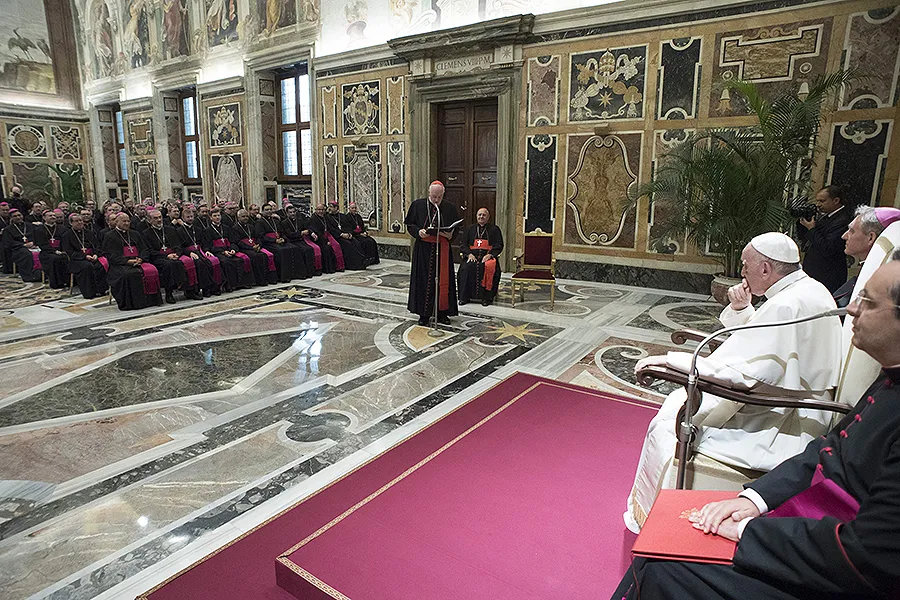
Vatican City, Dec 13, 2019 / 03:00 pm (CNA).- A senior official at the Congregation for the Doctrine of the Faith has defended clerical celibacy in the wake of the abuse crisis.
In an essay published in a Spanish magazine, Fr. Jordi Bertomeu Farnós said that there is “no evidence” celibacy has any relation to instances of sexual abuse, and warned that priests have been unfairly branded a suspect class.
In the essay, published in Palabra Dec. 10, Fr. Farnós laid out the context of sexual abuse by Catholic priests, noting that the high-profile nature of the scandals has resulted in a number of mistaken presumptions about the causes of abuse.
“Although unfortunately, in all social classes, professions, ethnic groups and, of course, religions, there is the phenomenon of child abuse, Catholic priests are seen or even increasingly treated as ‘suspects’ of having committed this horrible crime.”
Speaking against attempts to link the discipline of celibacy to crimes of sexual abuse, Farnós said that “regardless of other circumstances and arguments that have emerged in the recent Synod for the Amazon,” “this conclusion does not present any logical connection with the problem we are dealing with here: there is no scientific data that demonstrates that a married life would put an end to the deviant behavior of these few priests with this sexual disorder.”
“There is no evidence that priestly celibacy directly causes any deviant sexual addiction, as evidenced by those cases of men or women who, due to life’s circumstances, must live as celibate.”
“In addition,” he added, “celibacy has never been considered as a relevant parameter to identify abusers. Rather, most abusers are married men. Priests, mostly celibate men are… usually characterized precisely for their psychological balance, for their availability and selfless delivery to all, not only to the Catholic faithful.”
Farnós went on to offer a strident defence of the discipline of celibacy which, he said, was often unintelligible to modern society.
“According to some, in a sexually uninhibited and eroticized society… with numerous cases of addiction to all kinds of pornography and sexual deviations or paraphilias, priestly celibacy would be a pernicious life option,” he said.
According to this mindset, Farnós argued, celibacy is only recognized as “perpetual self-censorship of sexual desire,” and must lead to “psychological problems related to immaturity” that result in pedophilia.
“If the experience of celibacy has always been countercultural,” Farnós says, today it is “even more” so.
“Our society needs many young people to show everyone the goodness of living a true, chaste and free love. Living the consecration as ‘anointing’ and not simply ‘function’ encourages everyone, particularly those who have received the marriage vocation, to surrender without fainting despite daily difficulties,” he said.
“Priests are called, therefore, to surrender with a totalizing love to be ‘signs’ of a more real love than any utopia.”
Pointing to other examples of institutions rocked by abuse scandals, Fernós said that attempts to link celibacy to abuse lacked evidence.
“The data offered by other Christian and non-Christian churches, without celibate sacred ministers, belies that claim,” he said, pointing to the example of the Unity Church of Australia, which has 240,000 members, no hierarchy, and which elects married male and female clergy, but has recently made headlines for 2,500 cases of child abuse.
“Contrast such data with the Catholic Church, with 466,000 priests and 6,000 cases reported to the Congregation for the Doctrine of the Faith,” he said.
In the essay, Farnós pointed out that while the vast majority of cases of sexual abuse occur in the family, no one draws the conclusion that family members are ipso facto prone to abuse.
“If 73% of sexual abuse of minors seems to occur in the family environment, it cannot be affirmed that ‘being a father or being a mother predisposes to abuse,’” he said.
Farnós said that media coverage of the scandals had rightly highlighted the seriousness of all cases, but given rise to “certain statements destined to provoke the social panic and discredit of the Church, unfairly stigmatizing the social group of the clergy.”
Noting that the CDF has received approximately 6,000 cases of abuse world-wide, “an excessive number that shames us as Christians and particularly as priests,” Farnós said that priest account for only 3% of abuse cases reported to civil authorities.
“In the last two decades, we have attended with pain, particularly in some regions of the Catholic world, to an unworthy, improper, inconsiderate and even vexatious treatment of priests for the mere fact of [their] being [priests],” he said, pointing to “irresponsible” coverage of clerical abuse by the media.
The CDF official did, however, acknowledge that the vast majority of sexual abuse cases in the Church, some 80%, involve men preying on boys or young men, but warned against drawing any causal link between homosexuality as an orientation and a disposition to abuse.
Despite what Farnós called “certain ultraconservative ideological positions,” the data available to the CDF showed that “there is no direct relationship between homosexuality and pedophilia or between the latter and a ‘progressive style’ of clergy.”
“Affirming the direct connection of homosexuality with pedophilia from the data […] not only involves the commission of a great injustice, but also the criminalization of a certain sexual identity,” Farnós said, while at the same time observing that cultures of active homosexuality were a contributing factor to sexual abuse.
“It is […] possible to affirm that a certain homosexual subculture typical of some clerical groups and present in certain seminars or novitiates, with the consequent tolerance towards active homosexual behaviors, can lead to pedophilia.”
These, Fornós said, “deserve greater attention from pastors, who have the pastoral and disciplinary means to invite [clerics] by example, the word and even coercion to a chaste life that does not pose a danger or scandal for the priest himself and for the Church.”
Offering his own reflections on preventing future abuse, he said that bishops need to focus on the selection of candidates for the priesthood, moving away from “a superficial predisposition to welcome all,” and identifying men “capable of living loneliness as a moment of grace and maturation, integrating aggressiveness and maintaining healthy relationships with adult people for a long time.”
“We should insist on candidates for ministry [suitable for] their future public and social role,” he said.
“They will be moral reference points and, therefore, should be exercised from the first moment of their formation in great self-control, with the aim of never scandalizing or even moving anyone away from the faith, the great gift that sustains us.”
If you value the news and views Catholic World Report provides, please consider donating to support our efforts. Your contribution will help us continue to make CWR available to all readers worldwide for free, without a subscription. Thank you for your generosity!
Click here for more information on donating to CWR. Click here to sign up for our newsletter.




“Despite what Farnós called “certain ultraconservative ideological positions,” the data available to the CDF showed that “there is no direct relationship between homosexuality and pedophilia”
That is dodging the fact that much of the abuse was not pedophilia; the victims were post-pubescent boys. I think that it has clearly been shown that the vast majority of the abuse was homosexual.
Given that the vast majority of priests are gay, it shouldn’t;t be surprising that the vast majority of cases involve boys or men. If 100% of the men involved have taken vows of celibacy and there is no causal connection between celibacy and the abuse, then even if 100% of all of the cases involved abuse of men or boys it would also be no more likely to show causation.
“the vast majority of priests are gay”
Oh? According to whom? What evidence do you have to support such a claim?
‘If 100% of the men involved have taken vows of celibacy and there is no causal connection between celibacy and the abuse,”
The research I have seen shows that only about 3% of priests have committed abuse. Clearly there is no causal connection between celibacy and abuse or the number would be much higher.
“then even if 100% of all of the cases involved abuse of men or boys it would also be no more likely to show causation.”
Your argument can’t be made unless we had statistics showing how many priests are homosexual, and what percentage of them committed abuse. If you were able to show that the percentage of priests who are homosexual and who committed abuse was no higher than the percentage of non-homosexual priests who did so, that would support your claim. However, that 80% of the abuse was homosexual in nature is quite telling.
Although the article acknowledges there is also no link between homosexuality and sexual abuse, it goes no to point out that 80% of reported incidents of sexual abuse involve gay men — without acknowledging that 100% of sexual predator priests (whether gay or heterosexual) take vows of celibacy. Neither celibacy nor homosexuality “cause” anyone to be a sexual predator.
Perhaps not; but homosexuality appears to increase the chances, given the 80% statistic.
It doesn’t take much research to discover that the majority of sexual abuse is perpetrated by sexually active men, many of whom are “happily married?”